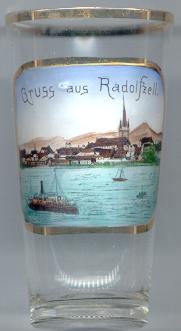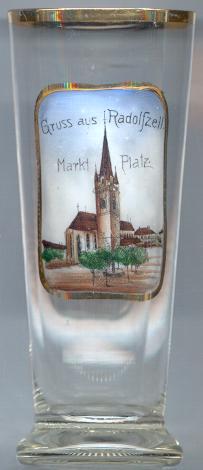

|
| DEUTSCHLAND | GERMANY |
| Bundesland: Baden-Württemberg | |
| Regierungsbezirk: Freiburg | |
| Landkreis: Konstanz |
 Radolfzell am Bodensee is situated at an elevation of 398 m on Lake Constance (German: Bodensee).
Around AD 826 the Cella Ratoldi was founded by bishop Radolf. In 830 Radolf brought the bones of the martyrs Theopontus and Senesius from Asia Minor to Radolfzell
and buried them in his chapel. Later, parts of the skull of St. Zeno, bishop of Verona, were brought to Radolfzell. In 1100 a new, separate market place
was founded by the abbot of Reichenau, Ulrich von Dapfen. Abbott Albrecht von Ramstein confirmed the privileges of Radolfzell in 1267. Between 1454 and 1805 Radolfzell
was part of Anterior Austria (see map).
Antipope John (XXIII), who had attended the Council of Konstanz 1415, had abdicated there but renounced his abdication and fled to Freiburg where he was captured.
He was kept in Radolfzell between 17 May and 3 June 1415. He accepted his deposition on 29 May. The town was unsuccessfully besieged by the peasants in 1529.
The Habsburg rulers frequently visited Radolfzell, in 1563 Emperor Ferdinand I visited the town. During the Thirty Years' War the plague killed all but about 400 inhabitants of Radolfzell.
The opening of the railway line from Waldshut, Schaffhausen, Singen, Radolfzell to Konstanz
in 1863 was celebrated by the presence of Grand Duke
Friedrich I of Baden.
Radolfzell am Bodensee is situated at an elevation of 398 m on Lake Constance (German: Bodensee).
Around AD 826 the Cella Ratoldi was founded by bishop Radolf. In 830 Radolf brought the bones of the martyrs Theopontus and Senesius from Asia Minor to Radolfzell
and buried them in his chapel. Later, parts of the skull of St. Zeno, bishop of Verona, were brought to Radolfzell. In 1100 a new, separate market place
was founded by the abbot of Reichenau, Ulrich von Dapfen. Abbott Albrecht von Ramstein confirmed the privileges of Radolfzell in 1267. Between 1454 and 1805 Radolfzell
was part of Anterior Austria (see map).
Antipope John (XXIII), who had attended the Council of Konstanz 1415, had abdicated there but renounced his abdication and fled to Freiburg where he was captured.
He was kept in Radolfzell between 17 May and 3 June 1415. He accepted his deposition on 29 May. The town was unsuccessfully besieged by the peasants in 1529.
The Habsburg rulers frequently visited Radolfzell, in 1563 Emperor Ferdinand I visited the town. During the Thirty Years' War the plague killed all but about 400 inhabitants of Radolfzell.
The opening of the railway line from Waldshut, Schaffhausen, Singen, Radolfzell to Konstanz
in 1863 was celebrated by the presence of Grand Duke
Friedrich I of Baden.

The  minster church Unser Lieben Frau (Lady church) [right] goes back to the 'Cella Ratolfi' of bishop Radolf.
The present-day church in Late Gothic style replaced an earlier church presumably of the Romanesque period. The upper part of the church tower was replaced by a
Neo-Gothic spire in 1903 [see the picture on the glass].
minster church Unser Lieben Frau (Lady church) [right] goes back to the 'Cella Ratolfi' of bishop Radolf.
The present-day church in Late Gothic style replaced an earlier church presumably of the Romanesque period. The upper part of the church tower was replaced by a
Neo-Gothic spire in 1903 [see the picture on the glass].
The cartographer Martin Waldseemüller (ca.1470–ca.1522) was born in Radolfzell. He coined the name America
(named for Amerigo Vespucci) and used it for the first time in his treatise Cosmographiae Introductio, on a globe and in
his world map, all of 1507. The map soon disappeared and was found again only in 1901 in the library of castle Wolfegg where it
is still kept.
![[scale]](lineal.jpg)